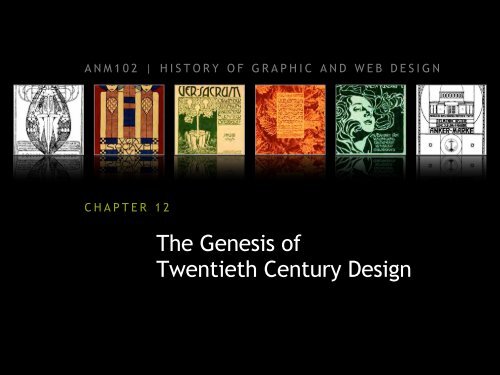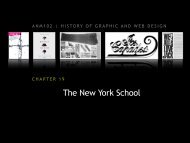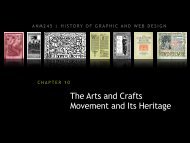chapter 12: the genesis of twentieth century design - ANM102 ...
chapter 12: the genesis of twentieth century design - ANM102 ...
chapter 12: the genesis of twentieth century design - ANM102 ...
You also want an ePaper? Increase the reach of your titles
YUMPU automatically turns print PDFs into web optimized ePapers that Google loves.
<strong>ANM102</strong> | HISTORY OF GRAPHIC AND WEB DESIGN<br />
CHAPTER <strong>12</strong><br />
The Genesis <strong>of</strong><br />
Twentieth Century Design
THE GENESIS OF TWENTIETH CENTURY DESIGN<br />
• As <strong>the</strong> 19th <strong>century</strong> drew to a close and <strong>the</strong><br />
20th <strong>century</strong> bega, <strong>design</strong>ers across <strong>the</strong><br />
disciplines <strong>of</strong> architecture, fashion, graphic,<br />
and product <strong>design</strong> searched for new ways to<br />
express <strong>the</strong>mselves.<br />
• The <strong>design</strong> <strong>of</strong> <strong>the</strong> Art Nouveau focused on<br />
creating invented forms ra<strong>the</strong>r than relying on<br />
<strong>the</strong> historical models <strong>of</strong> <strong>the</strong> Victorian era.<br />
• But <strong>the</strong> 20th <strong>century</strong> brought about new<br />
inspiration involving rectilinear motifs and<br />
spacial organization. Artists like Frank Lloyd<br />
Wright, Charles Rennie and Margaret<br />
(Macdonald) Mackintosh, Josef H<strong>of</strong>fmann, and<br />
Peter Behrens brought about tremendous<br />
change and are particularly important<br />
influences for today’s <strong>design</strong>ers.<br />
CHAPTER <strong>12</strong>: THE GENESIS OF TWENTIETH CENTURY DESIGN<br />
William Pickering, title page for <strong>the</strong><br />
Book <strong>of</strong> Common Prayer, 1844.<br />
2
BOOK DESIGN<br />
Frank Lloyd Wright<br />
• Title page for<br />
The House Beautiful,<br />
1896 - 97<br />
• Underlying geometric<br />
structure imposes<br />
a strong order<br />
• Intricate textural<br />
<strong>design</strong><br />
CHAPTER <strong>12</strong>: THE GENESIS OF TWENTIETH CENTURY DESIGN<br />
William Pickering, title page for <strong>the</strong><br />
Book <strong>of</strong> Common Prayer, 1844.<br />
3
DECORATIVE DESIGN<br />
CHAPTER <strong>12</strong>: THE GENESIS OF TWENTIETH CENTURY DESIGN<br />
William Pickering, title page for <strong>the</strong><br />
Book <strong>of</strong> Common Prayer, 1844.<br />
4
Margaret Macdonald<br />
• Margaret Macdonald<br />
Mackintosh<br />
• poster for <strong>the</strong><br />
Glasgow Institute <strong>of</strong><br />
<strong>the</strong> Fine Arts, 1895<br />
CHAPTER <strong>12</strong>: THE GENESIS OF TWENTIETH CENTURY DESIGN<br />
William Pickering, title page for <strong>the</strong><br />
Book <strong>of</strong> Common Prayer, 1844.<br />
5
Margaret Macdonald<br />
• 1896, reproduced in<br />
Ver Sacrum in 1901<br />
• Depicts Wisdom<br />
protecting her<br />
children within <strong>the</strong><br />
leaflike shelter <strong>of</strong><br />
her hair before a<br />
symbolic tree <strong>of</strong><br />
knowledge<br />
• Linear structure<br />
based on<br />
Macdonald’s<br />
metalwork<br />
CHAPTER <strong>12</strong>: THE GENESIS OF TWENTIETH CENTURY DESIGN<br />
William Pickering, title page for <strong>the</strong><br />
Book <strong>of</strong> Common Prayer, 1844.<br />
6
Margaret Macdonald<br />
CHAPTER <strong>12</strong>: THE GENESIS OF TWENTIETH CENTURY DESIGN<br />
William Pickering, title page for <strong>the</strong><br />
Book <strong>of</strong> Common Prayer, 1844.<br />
7
Charles Rennie Mackintosh<br />
• <strong>design</strong> <strong>the</strong>me <strong>of</strong> rising verticals<br />
and simple structural detail<br />
CHAPTER <strong>12</strong>: THE GENESIS OF TWENTIETH CENTURY DESIGN<br />
William Pickering, title page for <strong>the</strong><br />
Book <strong>of</strong> Common Prayer, 1844.<br />
8
PRODUCT DESIGN<br />
Charles Rennie Mackintosh<br />
• major contribution to <strong>design</strong> in<br />
interiors, furniture, patterned<br />
fabric and printed motifs<br />
CHAPTER <strong>12</strong>: THE GENESIS OF TWENTIETH CENTURY DESIGN<br />
William Pickering, title page for <strong>the</strong><br />
Book <strong>of</strong> Common Prayer, 1844.<br />
9
BOOK DESIGN<br />
Jessie Marion King<br />
CHAPTER <strong>12</strong>: THE GENESIS OF TWENTIETH CENTURY DESIGN<br />
William Pickering, title page for <strong>the</strong><br />
Book <strong>of</strong> Common Prayer, 1844.<br />
10
BOOK DESIGN<br />
Talwin Morris<br />
• bindings for <strong>the</strong> Red<br />
Letter Shakespeare<br />
series, c. 1908<br />
• standardized format<br />
• subtle graphic<br />
lyricism<br />
• economical<br />
commercial editions<br />
‣ http://www.fulltable.com/BG/<br />
tma.htm<br />
CHAPTER <strong>12</strong>: THE GENESIS OF TWENTIETH CENTURY DESIGN<br />
William Pickering, title page for <strong>the</strong><br />
Book <strong>of</strong> Common Prayer, 1844.<br />
11
BOOK DESIGN<br />
Talwin Morris<br />
• page ornament from <strong>the</strong> Red<br />
Letter Shakespeare series,<br />
c. 1908<br />
• <strong>the</strong> name for this small,<br />
modestly priced set derives<br />
from its two-color printing<br />
with character names in red<br />
• each volume had a graceful<br />
black ornament with<br />
a red oval<br />
CHAPTER <strong>12</strong>: THE GENESIS OF TWENTIETH CENTURY DESIGN<br />
William Pickering, title page for <strong>the</strong><br />
Book <strong>of</strong> Common Prayer, 1844.<br />
<strong>12</strong>
BOOK DESIGN<br />
Talwin Morris<br />
• pages from <strong>the</strong> Red<br />
Letter Shakespeare<br />
series, c. 1908<br />
• Format included:<br />
rigorous linear<br />
structures and<br />
graceful ornamented<br />
capitals<br />
CHAPTER <strong>12</strong>: THE GENESIS OF TWENTIETH CENTURY DESIGN<br />
William Pickering, title page for <strong>the</strong><br />
Book <strong>of</strong> Common Prayer, 1844.<br />
13
POSTER DESIGN<br />
Gustav Klimt<br />
• poster for <strong>the</strong> first Vienna<br />
Secession exhibition, 1898<br />
• large open space in <strong>the</strong><br />
center is unprecedented<br />
in Western graphic <strong>design</strong><br />
CHAPTER <strong>12</strong>: THE GENESIS OF TWENTIETH CENTURY DESIGN<br />
William Pickering, title page for <strong>the</strong><br />
Book <strong>of</strong> Common Prayer, 1844.<br />
14
POSTER DESIGN<br />
Koloman Moser<br />
• fifth Vienna Secession<br />
exhibition poster, 1899<br />
• metallic gold bronze<br />
figure and olive green<br />
background are printed<br />
on yellow tone paper<br />
that forms <strong>the</strong> contour<br />
lines <strong>of</strong> <strong>the</strong> image<br />
CHAPTER <strong>12</strong>: THE GENESIS OF TWENTIETH CENTURY DESIGN<br />
William Pickering, title page for <strong>the</strong><br />
Book <strong>of</strong> Common Prayer, 1844.<br />
15
COVER DESIGN<br />
Koloman Moser<br />
• cover <strong>design</strong> for<br />
Ver Sacrum, 1899<br />
• stencil-effect technique<br />
• reduction <strong>of</strong> <strong>the</strong> subject<br />
to black and white<br />
planes, gives <strong>the</strong><br />
suggestion <strong>of</strong> highcontrast<br />
photography<br />
CHAPTER <strong>12</strong>: THE GENESIS OF TWENTIETH CENTURY DESIGN<br />
William Pickering, title page for <strong>the</strong><br />
Book <strong>of</strong> Common Prayer, 1844.<br />
16
COVER DESIGN<br />
Alfred Roller<br />
• cover <strong>design</strong> for<br />
Ver Sacrum, initial<br />
issue, 1898<br />
• illustration <strong>of</strong> a tree<br />
whose growth<br />
destroyed its pot,<br />
allowing it to take<br />
root in firmer soil,<br />
to symbolize <strong>the</strong><br />
Secession<br />
CHAPTER <strong>12</strong>: THE GENESIS OF TWENTIETH CENTURY DESIGN<br />
William Pickering, title page for <strong>the</strong><br />
Book <strong>of</strong> Common Prayer, 1844.<br />
17
COVER DESIGN<br />
Alfred Roller<br />
• cover <strong>design</strong> for<br />
Ver Sacrum, 1898<br />
• stipple drawing<br />
<strong>of</strong> leaves becomes<br />
a frame for <strong>the</strong><br />
lettering<br />
• square gives <strong>the</strong><br />
impression <strong>of</strong> a<br />
collage element<br />
CHAPTER <strong>12</strong>: THE GENESIS OF TWENTIETH CENTURY DESIGN<br />
William Pickering, title page for <strong>the</strong><br />
Book <strong>of</strong> Common Prayer, 1844.<br />
18
HEADPIECE DESIGN<br />
Josef H<strong>of</strong>fmann<br />
• headpiece from <strong>the</strong><br />
premiere issue <strong>of</strong><br />
Ver Sacrum, 1898<br />
• berries, drawn in <strong>the</strong><br />
free contour line<br />
favored by many<br />
Secession artists<br />
• plaque that<br />
proclaims<br />
“Association <strong>of</strong> Visual<br />
Artists <strong>of</strong> Austria.<br />
Secession.”<br />
CHAPTER <strong>12</strong>: THE GENESIS OF TWENTIETH CENTURY DESIGN<br />
William Pickering, title page for <strong>the</strong><br />
Book <strong>of</strong> Common Prayer, 1844.<br />
19
TEXT FRAME DESIGN<br />
Joseph Olbrich<br />
• frame for Ver Sacrum<br />
article title, 1899<br />
• fluid repetition <strong>of</strong><br />
forms and symmetry<br />
• decorative botanical<br />
frame<br />
• dense black color<br />
• lively contrast to <strong>the</strong><br />
typographic page<br />
CHAPTER <strong>12</strong>: THE GENESIS OF TWENTIETH CENTURY DESIGN<br />
William Pickering, title page for <strong>the</strong><br />
Book <strong>of</strong> Common Prayer, 1844.<br />
20
PAGE DESIGN<br />
Josef H<strong>of</strong>fmann (border) and<br />
Koloman Moser (initial)<br />
• page from Ver Sacrum,<br />
1898<br />
• H<strong>of</strong>fmann’s modular berry<br />
motif and Moser’s<br />
figurative initial combine<br />
to produce an elegant page<br />
CHAPTER <strong>12</strong>: THE GENESIS OF TWENTIETH CENTURY DESIGN<br />
William Pickering, title page for <strong>the</strong><br />
Book <strong>of</strong> Common Prayer, 1844.<br />
21
PAGE DESIGN<br />
Alfred Roller<br />
• <strong>design</strong> and illustration<br />
for Ver Sacrum<br />
calendar for November<br />
1903<br />
• exuberant border<br />
brackets a seasonal<br />
illustration<br />
• hand-lettered,<br />
rectangular numbers<br />
and letters<br />
CHAPTER <strong>12</strong>: THE GENESIS OF TWENTIETH CENTURY DESIGN<br />
William Pickering, title page for <strong>the</strong><br />
Book <strong>of</strong> Common Prayer, 1844.<br />
22
PAGE DESIGN<br />
Alfred Roller<br />
• Roller’s lettering style in<br />
<strong>the</strong> early 1900s was <strong>the</strong><br />
precursor to <strong>the</strong> popular<br />
style <strong>of</strong> <strong>the</strong> sixties.<br />
CHAPTER <strong>12</strong>: THE GENESIS OF TWENTIETH CENTURY DESIGN<br />
William Pickering, title page for <strong>the</strong><br />
Book <strong>of</strong> Common Prayer, 1844.<br />
23
MONOGRAMS<br />
Various <strong>design</strong>ers<br />
• personal monograms, 1902<br />
• monograms <strong>design</strong>ed by<br />
Secession artists<br />
• reproduced in a 1902<br />
exhibition catalogue<br />
CHAPTER <strong>12</strong>: THE GENESIS OF TWENTIETH CENTURY DESIGN<br />
William Pickering, title page for <strong>the</strong><br />
Book <strong>of</strong> Common Prayer, 1844.<br />
24
POSTER ADVERTISING<br />
Koloman Moser<br />
• poster advertising Fromme’s<br />
calendar, 1899<br />
• used by <strong>the</strong> client with color<br />
changes for fifteen years<br />
• Moser’s <strong>design</strong> depicts a<br />
goddess <strong>of</strong> personal destiny<br />
holding a snake ring and<br />
hourglass, symbols for <strong>the</strong><br />
eternal circle <strong>of</strong> life and <strong>the</strong><br />
passing <strong>of</strong> time<br />
CHAPTER <strong>12</strong>: THE GENESIS OF TWENTIETH CENTURY DESIGN<br />
William Pickering, title page for <strong>the</strong><br />
Book <strong>of</strong> Common Prayer, 1844.<br />
25
POSTER DESIGN<br />
Koloman Moser<br />
• poster for <strong>the</strong> thirteenth Vienna<br />
Secession exhibition, 1902<br />
• ma<strong>the</strong>matical patterns <strong>of</strong> squares<br />
and rectangles contrast with <strong>the</strong><br />
circular forms <strong>of</strong> <strong>the</strong> figures and<br />
letterforms<br />
CHAPTER <strong>12</strong>: THE GENESIS OF TWENTIETH CENTURY DESIGN<br />
William Pickering, title page for <strong>the</strong><br />
Book <strong>of</strong> Common Prayer, 1844.<br />
26
BOOK ILLUSTRATION<br />
Walter Crane<br />
• diagram from Line and<br />
Form, 1900<br />
• widely read book foretold<br />
<strong>the</strong> evolution <strong>of</strong> form<br />
toward <strong>the</strong> geometric<br />
purity <strong>of</strong> <strong>the</strong> Vienna<br />
Secession and post-cubism<br />
avant-garde<br />
CHAPTER <strong>12</strong>: THE GENESIS OF TWENTIETH CENTURY DESIGN<br />
William Pickering, title page for <strong>the</strong><br />
Book <strong>of</strong> Common Prayer, 1844.<br />
27
PRODUCT DESIGN<br />
Alfred Roller<br />
• <strong>design</strong> for a pocket<br />
watch cover, 1900<br />
• night and day are<br />
symbolized by two<br />
snails with Asian yin<br />
yang attributes<br />
(positive and<br />
negative principles<br />
in nature)<br />
CHAPTER <strong>12</strong>: THE GENESIS OF TWENTIETH CENTURY DESIGN<br />
William Pickering, title page for <strong>the</strong><br />
Book <strong>of</strong> Common Prayer, 1844.<br />
28
POSTER DESIGN<br />
Alfred Roller<br />
• poster for <strong>the</strong> fourteenth Vienna<br />
Secession exhibition, 1902<br />
• dense geometric patterns<br />
animate <strong>the</strong> space<br />
CHAPTER <strong>12</strong>: THE GENESIS OF TWENTIETH CENTURY DESIGN<br />
William Pickering, title page for <strong>the</strong><br />
Book <strong>of</strong> Common Prayer, 1844.<br />
29
POSTER DESIGN<br />
Berthold Löffler<br />
• poster for a <strong>the</strong>ater and<br />
cabaret, c. 1907<br />
• masklike faces were<br />
simplified into elemental<br />
linear signs<br />
CHAPTER <strong>12</strong>: THE GENESIS OF TWENTIETH CENTURY DESIGN<br />
William Pickering, title page for <strong>the</strong><br />
Book <strong>of</strong> Common Prayer, 1844.<br />
30
TRADEMARKS<br />
Vienna Workshops<br />
• registered trademark<br />
and monogram<br />
applied to products <strong>of</strong><br />
<strong>the</strong> Vienna Workshops<br />
• harmony <strong>of</strong><br />
proportion, lyrical<br />
geometry, and clarity<br />
<strong>of</strong> form characterize<br />
<strong>the</strong> <strong>design</strong><br />
CHAPTER <strong>12</strong>: THE GENESIS OF TWENTIETH CENTURY DESIGN<br />
William Pickering, title page for <strong>the</strong><br />
Book <strong>of</strong> Common Prayer, 1844.<br />
31
ARCHITECTURE<br />
Josef H<strong>of</strong>fmann<br />
• Austrian architect and <strong>design</strong>er <strong>of</strong><br />
functional objects and consumer goods<br />
CHAPTER <strong>12</strong>: THE GENESIS OF TWENTIETH CENTURY DESIGN<br />
William Pickering, title page for <strong>the</strong><br />
Book <strong>of</strong> Common Prayer, 1844.<br />
32
POSTER DESIGN<br />
Josef H<strong>of</strong>fmann<br />
• Wiener Werkstätte<br />
exhibition poster, 1905<br />
• repetitive blue geometric<br />
pattern was created by a<br />
hand-stencil technique<br />
after <strong>the</strong> lettering and<br />
two lower rectangles were<br />
printed by lithography<br />
• This lettering was<br />
combined with o<strong>the</strong>r<br />
patterns for use in an<br />
advertisement and o<strong>the</strong>r<br />
posters<br />
CHAPTER <strong>12</strong>: THE GENESIS OF TWENTIETH CENTURY DESIGN<br />
William Pickering, title page for <strong>the</strong><br />
Book <strong>of</strong> Common Prayer, 1844.<br />
33
BOOKPLATE DESIGN<br />
Josef H<strong>of</strong>fmann<br />
• bookplate <strong>design</strong>, 1903<br />
• in a large series <strong>of</strong> figure studies,<br />
H<strong>of</strong>fmann reduced <strong>the</strong> image to<br />
elongated contours and simple shapes<br />
signifying hair or hats<br />
CHAPTER <strong>12</strong>: THE GENESIS OF TWENTIETH CENTURY DESIGN<br />
William Pickering, title page for <strong>the</strong><br />
Book <strong>of</strong> Common Prayer, 1844.<br />
34
PRODUCT DESIGN<br />
Josef H<strong>of</strong>fmann<br />
• functional furniture,<br />
flatware, glasses and<br />
fabric all maintain his<br />
trademark use <strong>of</strong> simple<br />
black and white elements<br />
on an elongated vertical<br />
or horizontal plane.<br />
CHAPTER <strong>12</strong>: THE GENESIS OF TWENTIETH CENTURY DESIGN<br />
William Pickering, title page for <strong>the</strong><br />
Book <strong>of</strong> Common Prayer, 1844.<br />
35
PRODUCT DESIGN<br />
Peter Behrens<br />
• German artist, <strong>design</strong>er,<br />
and architect was an early<br />
advocate <strong>of</strong> sans serif<br />
typography and use a grid<br />
system to organize<br />
elements in his layouts.<br />
• He is considered to be <strong>the</strong><br />
first industrial <strong>design</strong>er<br />
for his manufactured<br />
products such as<br />
streetlamps and tea<br />
kettles.<br />
CHAPTER <strong>12</strong>: THE GENESIS OF TWENTIETH CENTURY DESIGN<br />
William Pickering, title page for <strong>the</strong><br />
Book <strong>of</strong> Common Prayer, 1844.<br />
36
CATALOGUE DESIGN<br />
Peter Behrens<br />
• catalogue page for<br />
AEG teakettles, 1908<br />
• variations <strong>of</strong> <strong>the</strong><br />
modular system <strong>of</strong><br />
interchangeable,<br />
shapes, handles,<br />
materials, and<br />
textures are shown<br />
• spatial division by<br />
rules to create zones<br />
<strong>of</strong> information<br />
CHAPTER <strong>12</strong>: THE GENESIS OF TWENTIETH CENTURY DESIGN<br />
William Pickering, title page for <strong>the</strong><br />
Book <strong>of</strong> Common Prayer, 1844.<br />
37
BOOK DESIGN<br />
Peter Behrens<br />
• text pages for<br />
Celebration <strong>of</strong> Life and<br />
Art. A Consideration<br />
<strong>of</strong> <strong>the</strong> Theater as<br />
<strong>the</strong> Highest Symbol <strong>of</strong><br />
a Culture, 1900<br />
• blue-gray borders and<br />
red initials surrounded<br />
by rust-colored<br />
decorations frame <strong>the</strong><br />
unprecedented<br />
sans-serif running text<br />
CHAPTER <strong>12</strong>: THE GENESIS OF TWENTIETH CENTURY DESIGN<br />
William Pickering, title page for <strong>the</strong><br />
Book <strong>of</strong> Common Prayer, 1844.<br />
38
BOOK DESIGN<br />
Peter Behrens<br />
• title and dedication<br />
pages for a 25-page<br />
booklet called a<br />
Celebration <strong>of</strong> Life<br />
and Art, 1900<br />
• <strong>the</strong> layout explored<br />
formal geometric<br />
<strong>design</strong> motifs<br />
CHAPTER <strong>12</strong>: THE GENESIS OF TWENTIETH CENTURY DESIGN<br />
William Pickering, title page for <strong>the</strong><br />
Book <strong>of</strong> Common Prayer, 1844.<br />
39
BOOK DESIGN<br />
Peter Behrens<br />
• cover for Dokumente des<br />
Modernen Kunstgewerbes<br />
(Documents <strong>of</strong> Modern<br />
Applied Arts,) 1901<br />
• decorative geometric <strong>design</strong><br />
and sans-serif lettering<br />
based on a square,<br />
foreshadow <strong>the</strong> style <strong>of</strong><br />
art deco <strong>design</strong> <strong>of</strong> <strong>the</strong><br />
1920s and 1930s<br />
CHAPTER <strong>12</strong>: THE GENESIS OF TWENTIETH CENTURY DESIGN<br />
William Pickering, title page for <strong>the</strong><br />
Book <strong>of</strong> Common Prayer, 1844.<br />
40
FONT DESIGN<br />
Peter Behrens<br />
• Akzindenz Grotesk (referred<br />
to as Standard in US) is<br />
<strong>design</strong>ed by <strong>the</strong> Berthold<br />
Foundry.<br />
• showed 10 variations <strong>of</strong> <strong>the</strong><br />
same font<br />
• <strong>design</strong>ers and compositors<br />
could create unified<br />
contrast and emphasis in<br />
layouts with using only one<br />
font<br />
CHAPTER <strong>12</strong>: THE GENESIS OF TWENTIETH CENTURY DESIGN<br />
William Pickering, title page for <strong>the</strong><br />
Book <strong>of</strong> Common Prayer, 1844.<br />
41
LAYOUT DIAGRAM<br />
J. L. M. Lauweriks<br />
• <strong>the</strong>se diagrams<br />
illustrate Dutch<br />
architect J. L. M.<br />
Lauweriks’s<br />
compositional <strong>the</strong>ory<br />
elaborating grid<br />
systems from a<br />
square circumscribed<br />
around a circle.<br />
CHAPTER <strong>12</strong>: THE GENESIS OF TWENTIETH CENTURY DESIGN<br />
William Pickering, title page for <strong>the</strong><br />
Book <strong>of</strong> Common Prayer, 1844.<br />
42
ARCHITECTURE<br />
Peter Behrens<br />
• Anchor Linoleum<br />
exhibition pavilion, 1906<br />
• classical forms<br />
and proportions are<br />
combined with<br />
ma<strong>the</strong>matically derived<br />
geometric structure<br />
and pattern in a search<br />
for a <strong>twentieth</strong>-<strong>century</strong><br />
language <strong>of</strong> form<br />
CHAPTER <strong>12</strong>: THE GENESIS OF TWENTIETH CENTURY DESIGN<br />
William Pickering, title page for <strong>the</strong><br />
Book <strong>of</strong> Common Prayer, 1844.<br />
43
POSTER DESIGN<br />
Peter Behrens<br />
• poster for <strong>the</strong> Anchor<br />
Linoleum exhibition<br />
pavilion, 1906<br />
• Lauweriks’s grid <strong>the</strong>ory is<br />
applied to graphic <strong>design</strong><br />
CHAPTER <strong>12</strong>: THE GENESIS OF TWENTIETH CENTURY DESIGN<br />
William Pickering, title page for <strong>the</strong><br />
Book <strong>of</strong> Common Prayer, 1844.<br />
44
BOOK DESIGN<br />
Peter Behrens<br />
• guidebook covers<br />
for <strong>the</strong> AEG pavilion<br />
at <strong>the</strong> German<br />
Shipbuilding<br />
Exhibition, 1908<br />
• translation drawing<br />
reduces <strong>the</strong><br />
architectural<br />
structure to flat<br />
planes<br />
• lettering became a<br />
basis for <strong>the</strong> AEG<br />
visual identification<br />
system as shown in<br />
<strong>the</strong>ir logo<br />
CHAPTER <strong>12</strong>: THE GENESIS OF TWENTIETH CENTURY DESIGN<br />
William Pickering, title page for <strong>the</strong><br />
Book <strong>of</strong> Common Prayer, 1844.<br />
45
ARCHITECTURE<br />
Peter Behrens<br />
• architecture was part <strong>of</strong><br />
<strong>the</strong> AEG corporate <strong>design</strong><br />
program that included<br />
<strong>design</strong>s for storefronts to<br />
<strong>the</strong> massive Turbine Hall<br />
• became <strong>the</strong> prototype for<br />
future <strong>design</strong> evolution—<br />
o<strong>the</strong>r than <strong>the</strong> AEG logo<br />
and <strong>the</strong> name on <strong>the</strong> end<br />
<strong>of</strong> <strong>the</strong> ro<strong>of</strong>, <strong>the</strong>re is little<br />
ornament in detail<br />
• structure and proportions<br />
suggest its function—an<br />
industrial factory for <strong>the</strong><br />
assembly <strong>of</strong> steam<br />
turbines<br />
CHAPTER <strong>12</strong>: THE GENESIS OF TWENTIETH CENTURY DESIGN<br />
William Pickering, title page for <strong>the</strong><br />
Book <strong>of</strong> Common Prayer, 1844.<br />
46
Peter Behrens<br />
• Behrens played a key role<br />
among <strong>design</strong>ers who<br />
revolted against <strong>the</strong><br />
Victorian historicism and art<br />
nouveau <strong>design</strong>, adopting a<br />
more spartan approach, void<br />
<strong>of</strong> any decoration.<br />
CHAPTER <strong>12</strong>: THE GENESIS OF TWENTIETH CENTURY DESIGN<br />
William Pickering, title page for <strong>the</strong><br />
Book <strong>of</strong> Common Prayer, 1844.<br />
47
LOGO DESIGN<br />
Edward Johnston<br />
• The London<br />
Underground symbol,<br />
revised by Edward<br />
Johnston in 1918<br />
• shown is <strong>the</strong> 1972<br />
version which is still<br />
used today<br />
CHAPTER <strong>12</strong>: THE GENESIS OF TWENTIETH CENTURY DESIGN<br />
William Pickering, title page for <strong>the</strong><br />
Book <strong>of</strong> Common Prayer, 1844.<br />
48
KEY TERMS<br />
The Studio<br />
<strong>the</strong> first <strong>of</strong> nearly a dozen new 1890s European art<br />
periodicals, it had a strong influence on a group <strong>of</strong><br />
young Scottish artists who became friends at <strong>the</strong><br />
Glasgow School <strong>of</strong> Art.<br />
The Glasgow School (The Four)<br />
a collaboration <strong>of</strong> four students from <strong>the</strong> Glasgow<br />
School <strong>of</strong> Art: Charles Rennie Mackintosh, J. Herbert<br />
McNair, and Margaret and Frances Macdonald. These<br />
young collaborators developed a unique style <strong>of</strong> lyrical<br />
originality and symbolic complexity. They innovated a<br />
geometric style <strong>of</strong> composition by tempering floral and<br />
curvilinear elements with strong rectilinear structure.<br />
Their <strong>design</strong>s are distinguished by symbolic imagery<br />
and stylized form. Bold, simple lines define flat planes<br />
<strong>of</strong> color. Their influence on <strong>the</strong> Continent became<br />
important transitions to <strong>the</strong> aes<strong>the</strong>tic <strong>of</strong> <strong>the</strong> <strong>twentieth</strong><br />
<strong>century</strong>.<br />
CHAPTER <strong>12</strong>: THE GENESIS OF TWENTIETH CENTURY DESIGN<br />
Sezessionstil (The Vienna Secession)<br />
formed by Gustav Klimt, Joseph Maria Olbrich, Josef<br />
H<strong>of</strong>fman, and Koloman Moser. It came into being on<br />
April 3, 1897, when <strong>the</strong> younger members <strong>of</strong> <strong>the</strong><br />
Künstlerhaus, <strong>the</strong> Viennese Creative Artists’<br />
Association, resigned in a stormy protest. Technically,<br />
<strong>the</strong> refusal to allow foreign artists to participate in<br />
Künstlerhaus exhibitions was <strong>the</strong>ir main issue, but <strong>the</strong><br />
clash between tradition and new ideas emanating from<br />
France, England, and Germany lay at <strong>the</strong> heart <strong>of</strong> <strong>the</strong><br />
conflict. Theirs became a countermovement to <strong>the</strong><br />
floral art nouveau that flourished in o<strong>the</strong>r parts <strong>of</strong><br />
Europe. The group’s rapid evolution ran from <strong>the</strong><br />
illustrative allegorical style <strong>of</strong> symbolist painting to a<br />
French-inspired floral style to <strong>the</strong> mature style, which<br />
drew inspiration from <strong>the</strong> Glasgow School. A major<br />
difference between this group and art nouveau is <strong>the</strong><br />
artists’ love <strong>of</strong> clean, simple, sans-serif lettering,<br />
ranging from flat, blocky slabs to fluidly calligraphic<br />
forms. Their elegant Ver Sacrum (Sacred Spring) was<br />
more a <strong>design</strong> laboratory than a magazine.<br />
William Pickering, title page for <strong>the</strong><br />
Book <strong>of</strong> Common Prayer, 1844.<br />
49
KEY TERMS<br />
Ver Sacrum (Sacred Spring)<br />
Designed by <strong>the</strong> Vienna Secession and published from<br />
1898 until 1903, this was more a <strong>design</strong> laboratory<br />
than a magazine. It focused on experimentation and<br />
graphic excellence and enabled <strong>design</strong>ers to develop<br />
innovative graphics as <strong>the</strong>y explored <strong>the</strong> merging <strong>of</strong><br />
text, illustration, and ornament into a lively unity. The<br />
magazine had an unusual square format, and its covers<br />
<strong>of</strong>ten combined hand lettering with bold line drawing<br />
printed in color on a colored background.<br />
Line and Form<br />
A book by Walter Crane in which he diagrammed <strong>the</strong><br />
evolution toward elemental geometric form and<br />
foretold <strong>the</strong> geometric purity <strong>of</strong> <strong>the</strong> Vienna Secession<br />
and postcubism -cubism avant-garde.<br />
CHAPTER <strong>12</strong>: THE GENESIS OF TWENTIETH CENTURY DESIGN<br />
Wiener Werkstätte (Vienna Workshops)<br />
An outgrowth <strong>of</strong> Sezessionstil, this spiritual continuum<br />
<strong>of</strong> William Morris’s workshops sought a close union <strong>of</strong><br />
<strong>the</strong> fine and applied arts in <strong>the</strong> <strong>design</strong> <strong>of</strong> lamps,<br />
fabrics, and similar objects for everyday use, including<br />
books, greeting cards, and o<strong>the</strong>r printed matter. The<br />
goal was to <strong>of</strong>fer an alternative to poorly <strong>design</strong>ed,<br />
mass-produced articles and trite historicism. Function,<br />
honesty to materials, and harmonious proportions were<br />
important concerns; decoration was used only when it<br />
served <strong>the</strong>se goals and did not violate <strong>the</strong>m.<br />
Celebration <strong>of</strong> Life and Art:<br />
A Consideration <strong>of</strong> <strong>the</strong> Theater as <strong>the</strong><br />
Highest Symbol <strong>of</strong> a Culture<br />
This booklet by Peter Behrens may represent <strong>the</strong> first<br />
use <strong>of</strong> sans-serif type as running book text. All-capital,<br />
sans-serif type is also used in an unprecedented way<br />
on <strong>the</strong> title and dedication pages.<br />
William Pickering, title page for <strong>the</strong><br />
Book <strong>of</strong> Common Prayer, 1844.<br />
50
KEY TERMS<br />
Berthold Foundry<br />
<strong>design</strong>ed a family <strong>of</strong> ten sans-serif typeface that were<br />
variations on one original font. This Akzidenz Grotesk<br />
(called Standard in <strong>the</strong> United States) type family had<br />
a major influence on <strong>twentieth</strong>-<strong>century</strong> typography.<br />
Akzidenz Grotesk<br />
a typeface <strong>design</strong>ed by <strong>the</strong> Berthold Foundry and<br />
called Standard in <strong>the</strong> United States. This typeface<br />
permitted compositors to achieve contrast and<br />
emphasis within one family <strong>of</strong> typefaces.<br />
Behrensschrift<br />
Peter Behrens’s first typeface, released by <strong>the</strong><br />
Klingspor Foundry, was an attempt to reduce any<br />
poetic flourish marking <strong>the</strong> forms, <strong>the</strong>reby making<br />
<strong>the</strong>m more universal.<br />
CHAPTER <strong>12</strong>: THE GENESIS OF TWENTIETH CENTURY DESIGN<br />
Deutsche Werkbund<br />
(German Association <strong>of</strong> Craftsmen)<br />
Founded in 1907 in Munich, this association was<br />
created to inspire high-quality <strong>design</strong> in manufactured<br />
goods and architecture, advocating a marriage <strong>of</strong> art<br />
with technology. It recognized <strong>the</strong> value <strong>of</strong> machines<br />
and advocated <strong>design</strong> as a way to give form and<br />
meaning to all machine-made things, including<br />
buildings. Soon after it formed, two factions emerged.<br />
One, headed by Hermann Mu<strong>the</strong>sius, argued for <strong>the</strong><br />
maximum use <strong>of</strong> mechanical manufacturing and<br />
standardization <strong>of</strong> <strong>design</strong> for industrial efficiency. This<br />
group believed form should be determined solely by<br />
function and wanted to eliminate all ornament.<br />
Mu<strong>the</strong>sius saw simplicity and exactness as being both<br />
functional demands <strong>of</strong> machine manufacture and<br />
symbolic aspects <strong>of</strong> <strong>twentieth</strong>-<strong>century</strong> industrial<br />
efficiency and power. A union <strong>of</strong> artists and craftsmen<br />
with industry, he believed, could elevate <strong>the</strong><br />
functional and aes<strong>the</strong>tic qualities <strong>of</strong> mass production,<br />
particularly in low-cost consumer products. The o<strong>the</strong>r<br />
faction, led by Henry van de Velde, argued for <strong>the</strong><br />
primacy <strong>of</strong> individual artistic expression.<br />
William Pickering, title page for <strong>the</strong><br />
Book <strong>of</strong> Common Prayer, 1844.<br />
51
KEY FIGURES<br />
Frank Lloyd Wright<br />
Charles Rennie Mackintosh<br />
Margaret Macdonald Mackintosh<br />
Talwin Morris<br />
Gustav Klimt<br />
Josef H<strong>of</strong>fman<br />
Alfred Roller<br />
Peter Behrens<br />
Edward Johnston<br />
CHAPTER <strong>12</strong>: THE GENESIS OF TWENTIETH CENTURY DESIGN<br />
William Pickering, title page for <strong>the</strong><br />
Book <strong>of</strong> Common Prayer, 1844.<br />
52










